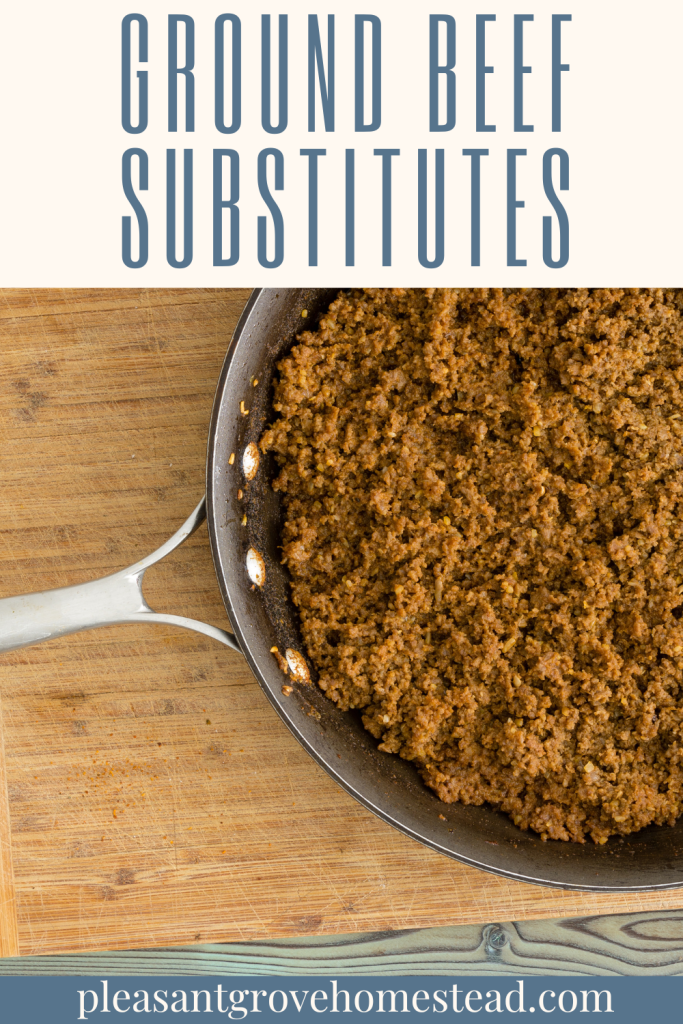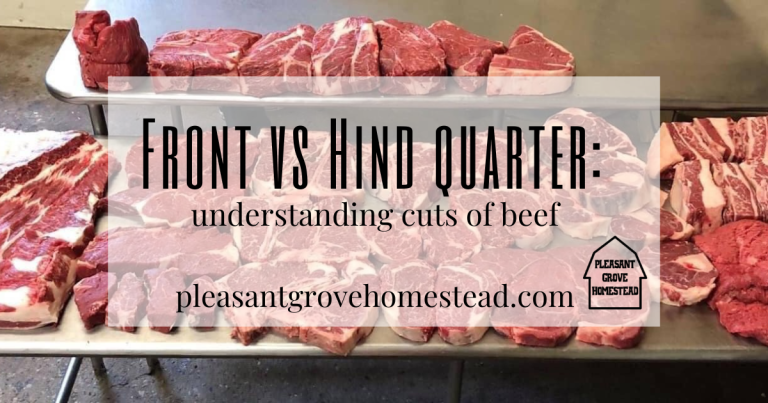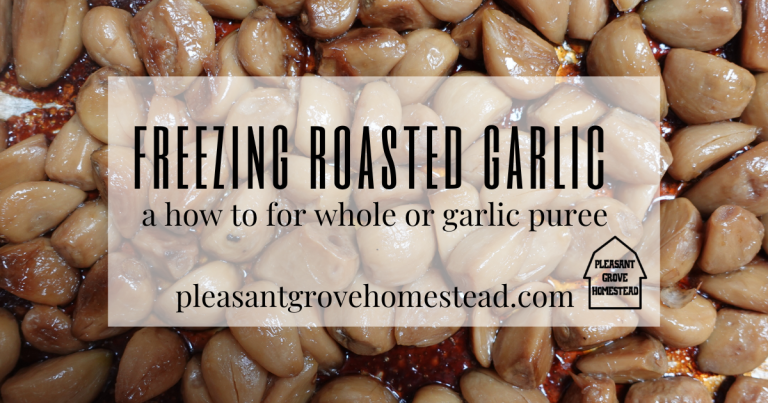Ground Beef Substitutes That Aren’t Vegan: Best Ways to stretch meat
This post may contain affiliate links. As an Amazon Associate, we earn from qualifying purchases.
While ground beef substitutes and plant-based meat alternatives are trending in every grocery store aisle, we’re taking a different approach here at Pleasant Grove Homestead. Beef—especially pasture-raised beef—is one of the few animal products that contains all nine essential amino acids in comparable amounts to what our bodies need. It’s also rich in vitamin B12, zinc, and iron—nutrients that are often missing in a plant-based diet. So while we don’t replace beef entirely, we’ve learned plenty of ways to stretch a pound of ground beef to feed more people, save money, and still enjoy that rich, hearty flavor. If your freezer or budget is running low, or you just want to use less meat while keeping meals satisfying, you’re in the right place.
Why Stretching Beef Is a Good Thing
There’s good news: you don’t need to give up beef to enjoy the health benefits of eating more whole-food ingredients.
- Beef provides animal protein, essential amino acids, and heme iron (which your body absorbs easily).
- Plant-based ingredients like lentils, mushrooms, and beans can bulk up meals with fiber, folate, and vitamin B.
- Mixing the two keeps that meaty flavor your taste buds love while lowering fat content and overall cost per meal.
Our goal isn’t imitation—no impossible burger or meatless ground beef here—but rather balance: using real ingredients to make hearty, nutrient-rich meals that feed a family well.
1. Lentils – The Closest Substitute for Texture and Nutrition
If there’s one ground beef alternative that blends seamlessly, it’s lentils—especially red lentils or brown lentils. When I was working with the Spend Smart, Eat Smart program at Iowa State University these lentil tacos were a crowd pleaser– but my tip was to use them as an addition to meat.
In taco meat, sloppy joes, or spaghetti sauce, add 1 cup cooked lentils to 1 pound ground beef. No one will notice, and you’ve doubled the fiber. Lentils are AMAZING because they cook very quickly compared to typical beans.
Cook lentils in broth or water until just tender, drain any excess liquid, and stir them into your beef mixture near the end of the meat browning. They absorb flavors from garlic powder, chili powder, tomato sauce beautifully.
Lentils have a similar texture to ground meat and deliver plenty of grams of protein and vitamin B. They’re one of our favorite real whole-food ingredients to stretch a meal without sacrificing nutrition.
2. Ground Pork – Flavorful, Affordable, and Rich in Protein
When we want to stay in the animal protein family, ground pork is our go-to blend.
- For lasagna, pizza sauce, and spaghetti sauce, mix ½ ground pork and ½ ground beef.
- For Korean beef bowls or sloppy joes, ground pork alone works beautifully.
- We often season with Italian seasoning, black pepper, and a splash of soy sauce or Worcestershire for extra umami.
- Purchasing Italian pork sausage still typically is cheaper than ground beef
Pork is a healthy alternative to beef when used wisely—high in protein, with lower saturated fat if you use lean cuts. Plus, it’s often cheaper than ground beef, making it a practical ground beef substitute. In our home we need 2 pounds of meat each meal, so I often cook 4 pounds (2 pounds pork, 2 pounds ground beef) and freeze the other two pounds for a future meal.
3. Ground Deer or Ground Lamb – Wild Flavor, Real Nutrition
If you’re lucky enough to have ground deer (venison) or ground lamb, they’re incredible beef alternatives.
Both are rich in animal protein but leaner than beef. Venison in particular has a hearty texture and bold flavor that shines in shepherd’s pie, gravy, or spaghetti sauce.
Did you know Iowa has a program where hunters give away their deer? You can learn more here! You can either have the hunter send it to the local locker or you can get the deer directly to process on your own. We have gotten many deer from this program.
4. Beans – The Classic Budget-Friendly Meat Extender
In tacos, shepherd’s pie, or chili, we often mix refried beans, black beans, or white beans with our ground beef.
Mash black beans in a large bowl with taco seasoning, then stir into cooked beef. The result? More servings, more fiber, and less meat—without compromising the texture of ground beef.
This combo also reduces fat content and adds heart-healthy fiber while keeping the dish flavorful. Serving beans on the side of taco night for those in your family who like them is always a good idea!
To make refried beans simply heat some pinto beans with pork lard. Use a potato masher to mash them and add a little cumin and salt to taste.
5. Mushrooms – For Umami Lovers
Mushrooms aren’t a vegetarian substitute for beef nutritionally, but they’re unmatched for flavor. Finely chop them in a food processor and sauté in olive oil before adding to your meat sauce.
They release moisture, so cook off excess water first. Add garlic powder, tomato paste, or Italian seasoning for a richer spaghetti sauce or gravy.
They provide B-vitamins and a similar texture to ground meat, making them a favorite in our favorite recipes like spaghetti other hearty dishes.
6. Simple Grains – Quinoa, Oats, and Bulgur
Adding grains is another way to make ground meat go further.
Cooked quinoa or bulgur blends well in spaghetti sauce and taco meat, while rolled oats can hold meatloaf or mashed potatoes together in shepherd’s pie.
They add bulk, texture, and fiber—ideal when you want to stretch your beef and reduce overall meat consumption.
7. Textured Vegetable Protein (TVP) or Wheat Gluten
For those who want to try vegetarian substitutes or plant-based meat, textured vegetable protein (TVP) or wheat gluten (seitan) can work well.
Look for Bob’s Red Mill TVP in health food stores. Rehydrate with tomato sauce, soy sauce, or vegetable broth before mixing into dishes. It’s high in grams of protein and low in fat.
These meat alternatives are made from plant protein (soy or wheat) and have a similar texture to beef, especially when browned with olive oil and black pepper.
8. Tofu or Tempeh – The Easy Vegan Ground Beef Substitute
If you’re following a plant-based diet or have food allergies, firm tofu or tempeh can serve as your vegan ground beef substitute.
Crumble firm tofu into a large bowl, season with vegan Worcestershire, chili powder, and garlic powder, then brown in olive oil until the tofu texture firms up. Add tomato paste or soy sauce to build umami flavors.
This makes an easy vegan filling for tacos, shepherd’s pie, or sloppy joes. It’s also a good way to introduce vegetarian alternatives into your favorite dishes while still focusing on real whole-food ingredients.
Other Money Saving Tips
Buy beef in bulk! You will get all different cuts of beef for a cheaper price per pound than the grocer. Also, you’ll be supporting local beef and ensuring it’s from the USA!
Keep cooked meat in your freezer or pantry! One of our most popular posts is using canned beef but we also always keep cooked hamburger in the freezer to make a quick meal.
Those proteins that are cooked ahead help us avoid eating out. One night of eating out for our family of six is about $60. That would buy quite a few pounds of ground beef!

Final Thoughts
Stretching ground beef isn’t about replacing the real thing with beyond meat or impossible foods. It’s about combining real whole-food ingredients—lentils, beans, mushrooms, and ground pork—to make hearty, nutritious meals that celebrate animal protein while reducing waste. So next time you’re short on beef, grab a bag of brown lentils, a few mushrooms, and maybe a pound of ground pork. You’ll feed more people, add nutrients, and still enjoy the unmistakable flavor of the real thing.

Front Quarter vs Hind Quarter Beef: What’s the Difference & What Do You Get?
This post may contain affiliate links. As an Amazon Associate, we earn from qualifying purchases. Buying a quarter of beef, half beef, or even a whole beef is one of the best ways to fill your freezer with high quality, locally processed beef. But if you’re new to buying beef in bulk, one of the biggest questions is: What’s the…

How to Freeze Roasted Garlic (Paste or Whole Cloves)
This post may contain affiliate links. As an Amazon Associate, we earn from qualifying purchases. Why This Is a Great Way for Garlic Lovers If you’ve seen the latest TikTok make-ahead hacks or are searching for the best way to preserve garlic, you’ll love this method. Roasted garlic brings a sweet, mellow flavor that transforms…

What to Do With Too Many Cherry Tomatoes: Recipes & Ideas from the Farm
This post may contain affiliate links. As an Amazon Associate, we earn from qualifying purchases. If you’ve ever grown cherry tomatoes, you already know how it goes. You plant one or two tomato plants in the spring, dreaming of sweet, juicy little tomatoes to snack on in the summer months. But then—suddenly—you’re swimming in them….
Pork Cut Chart: A printable guide for pig cuts
This post may contain affiliate links. As an Amazon Associate, we earn from qualifying purchases. Deciding to order bulk pork from a local producer is a great way to economically fill up your freezer with a large variety of high quality pork. However, it can be overwhelming to understand the cut sheet when the local…

Budget Friendly Meal Prep: Making a plan for meals
This post may contain affiliate links. As an Amazon Associate, we earn from qualifying purchases. Preparing meals on a budget is easier than you think! In this blog, we will discover how healthy eating can be budget friendly with easy family dinners. “Hey, what’s for dinner?” Ah, the age-old question that gets asked every. single….

Understanding differences in pork cuts: Loin vs. Shoulder
This post may contain affiliate links. As an Amazon Associate, we earn from qualifying purchases. Learn the difference between pork loin and pork shoulder and how you can use either for delicious meals. Both pieces of meat have unique characteristics to make them ideal for different dishes. Since you are purchasing a larger cut of meat,…






